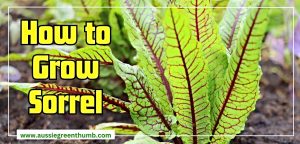The name Travellers Palm makes you think of a tree that might be helpful on a journey, a friend who is there along the way, or maybe a beautiful sight that makes a landscape photo worthy. The travellers palm is in fact all these things.
In our how to grow and care guide, we’ll introduce you to some facts about the travellers palm. We’ll go through how to care for your tree, how to propagate from seed or by division, pests and diseases that you might be dealing with, and some frequently asked questions.
More...
Family: | Strelitziaceae |
|---|---|
Genus: | Ravenala |
Species: | R. madagascariensis |
Common Names: | Travellers Palm and Travellers Tree |
Location: | Indoor and outdoor |
Type: | Tree |
Height: | Up to 12 metres |
Spread: | Up to 4.5 metres |
Sun requirements: | Full sun, partial shade |
Foliage Colour: | Orange, yellow, green |
Flower Colour: | White |
Flowering: | Summer |
Fruit: | Brown with bright blue seeds |
Maintenance level: | Low |
Poisonous for pets: | Yes |
Introducing Travellers Palm
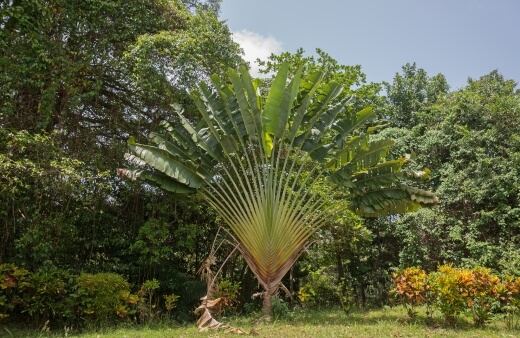
The name Travellers Palm is a bit deceiving because this tree isn’t actually a palm at all. If you look at the broad and fan-shaped leaves, you would probably think more of a banana tree.
Travellers palm is in fact part of the Strelitziaceae family but you might know it as the White Bird of Paradise, again because the flowers and structure really do make the plant look like a beautiful bird.
So if the travellers palm is not in fact a palm, then what is the name relating to? You’ll be glad to know that it helps provide a very important travelling resource – fresh water.
The bases of the leaves actually catch and accumulate rainwater, refreshing many a weary traveller. The bases are shaped like cups and have the ability to store a fair amount of water at a time.
The scientific name of the travellers palm reveals where this tree is native to, the beautiful rainforests of Madagascar. The name Ravenala is a reference to the Malagasy word ravinala. It means forest leaves which seems very appropriate.
Ravenala madagascariensis used to be thought of as a single species. There are however four different forms of this tree.
They are:
- Bemavo - this is the biggest and most common variety that you’ll find.
- Hiranirana – this variety usually pops up where there are breaks in the rainforest.
- Malama – this is the most rare of the varieties.
- Horonorona - this is the smallest of the varieties but is usually the one that is cultivated for ornamental reasons.
Features of the Ravenala madagascariensis
The travellers palm has some distinct features worth noting. When the tree is still young, the tree trunk is actually under the ground and the leaves then touch the ground surface.
When the trunk is eventually above ground, it drops its low leaves, and this creates rings of scars around it. The tree develops quite slowly. It only starts producing flowers from around ten years of age.
It flowers mostly during the summertime, but sometimes the travellers palm will surprise you with flowers during other times of the year.
In the summer, there is an ongoing abundance of flowers that are either white or a bright yellow colour. The flowers produce plenty of nectar which is actually a food for lemurs. After flowering comes a wooden type of fruit, filled with blue seeds.
Growing Travellers Palm in Australia
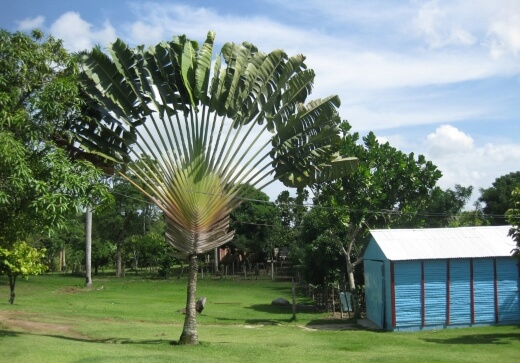
Best Soil for Travellers Palm
This tree needs a soil that can hold some water without becoming soggy. Aim for a rich and loamy soil and in terms of acidity, neutral to mild is perfect.


Get Your Free Guide:
Master Growing Australian Natives eBook
A Must Have Complete Guide for Every Australian Garden
Get Your Free Guide:
Master Growing Australian Natives eBook
A Must Have Complete Guide for Every Australian Garden
Learn more about loamy soil and its ingredients here.
Sunlight Preference
The travellers palm is a lover of the sun and can handle full sun exposure. If you plant it in partial shade though, it will love you still.
Temperature
Travellers palm needs the right temperature to thrive. It doesn’t like the cold – it’s a native of the lovely Madagascar. Any temperature below 15°C will start to unsettle the tree and if the temperature drops below 4°C it can actually kill your tree.
How to Propagate Travellers Palm

It’s possible to propagate a travellers palm using seed or by division. A quick and easy way is using the root suckers. You can divide these at the start of the rain season and then plant.
If you don’t mind a bit of extra effort, you can use seeds and plant them in a moist and sandy soil. You want to keep the planted seed at a temperature around 20°C. Just a heads up, the germination process is a slow one.
After about 2 months, you can transplant your seedlings into a soil that is rich and loamy. The seedlings will need full sun and some extra food – you can add some organic matter like moss to the soil when you plant them. This helps to keep roots moist.
Travellers Palm Care Tips
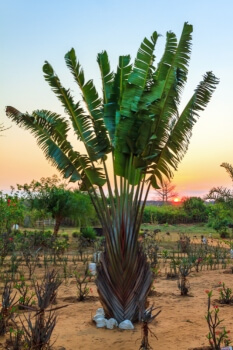
Pruning Travellers Tree
Some good news about the travellers palm is that it’s low maintenance. You might want to keep the root suckers at bay with some pruning so it doesn’t throw off the shape of the tree.
For your pruning tasks, check out our review of the best pruning saws you can easily get online.
Watering Schedule
The travellers palm needs soil that is moist all the time – it is native to a rainforest after all. It’s important not to overwater your tree.
Fertilising Travellers Palm
Travellers palm can grow in soil that is nutrient poor, but you ultimately want a healthy and fast growing tree. You can use a fertiliser that is rich in nitrogen when the tree is going through the growing season.
Pests and Diseases that May Affect Travellers Palm
Colletotrichum gloeosporioides
Colletotrichum gloeosporioides is a very common fungus that affects many crops all over the world. It particularly affects those growing in tropical areas. Some of the host plants that it attacks are tomato, citrus, and yams.
The fungus attacks damaged tissue and can produce different symptoms depending on the part of the tree affected. Fruit of the tree might have dark lesions that are black or brown. This is very common.
On the flowers, you might notice lesions that look a bit like streaks. Leaves that are infected start to have strange colour and patterns on them.
The stems will suffer from dieback and also a change in colour. You’ll need to dispose of the fruit and parts of the tree that are infected.
Leaf spot
Leaf spots are usually caused by fungus but sometimes they are from bacteria. Leaf spot is quite a common sight on trees and usually you don’t need to do much in terms of treatment.
If you’re looking for a natural defence, you can make up your own baking soda spray. Dissolve one teaspoon of baking soda into a litre of water. You can also add some liquid soap to the mix which helps it stick to the leaves.
Root rot
Root rot can be caused by overwatering which means the roots then don’t get enough oxygen and start to rot and die. Root rot can also be caused by fungus in your soil.
Sometimes the fungus has been in the soil for a while, but if the tree is watered too much a few times it then activates this fungus which takes over.
You’ll know you’re dealing with root rot in your tree if you notice that growth becomes stunted and it starts to wilt. Leaves are often discoloured and you’ll notice dieback as well.
It might be possible to save the tree if you can get rid of the infected roots before the infection spreads too far. If the infection is too far advanced, you’ll have to remove the tree.
Spider mites
Some of the early signs of spider mites include white or yellow spots on the leaves, a bronze or yellow patch in some parts of the tree, and what looks like a silk web on the stems or leaves.
Spider mites are quite easy to get rid of using a mix of alcohol and water. You can add a cup of alcohol to just under a litre of water and pop it into a spray bottle.
You can spray both sides of the leaves and then wipe them off with some paper towel. Another trusty defence to deal with spider mites naturally is neem oil. It’s a great repellent that actually smothers spider mites.
A neem oil application will be a more lasting solution to keep the pests under control and you can even use an insecticidal soap first, and then follow with your neem oil.
It can be tempting to go the chemical route first, but there are some great solutions that are kind to the environment too.
Travellers Palm Frequently Asked Questions
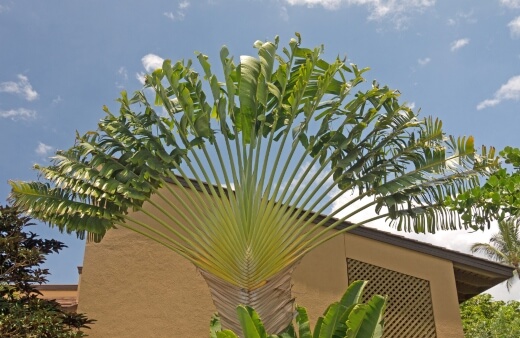
What kind of insects and animals does the nectar of the travellers palm attract?
This good looking tree is loved by birds and some bat species too.
Can you eat the seeds of the travellers palm?
You can indeed eat the seeds of the travellers palm. Oil from the seeds can be used for cooking and is similar to something like coconut butter or palm oil. Some parts of the plant like the leaves are toxic and should definitely be kept away from pets.
What are some of the uses of the travellers palm, besides catching and providing water?
The sap of the tree can be used to make sugar. The seed oil is antiseptic and the leaves are sometimes used to create roofing and a packaging material. The bark has been used as flooring for traditional huts.
We love palms. Well, we love all things gardening and greenery related. If you’re looking to do some research on another popular palm, you can read about the Rhapis palm here.
If you enjoyed our how to grow and care guide, and are looking for more gardening tips, inspiration, and enjoyable reading, sign up to our newsletter.
Wrapping Up Our Travellers Palm Growing and Care Guide
Imagine a tree that can produce an emergency water drinking supply in a drought. The travellers palm has earned itself a reputation as being a bit of a lifesaver.
Although your garden might not be a space where you are likely to be thirsty any time soon, the travellers palm is a gorgeous landscape tree with leaves that are as good looking as the flowers and fruits that it produces.
If you are keen to have your very own tree, propagation is super simple by division. The tree is low maintenance, needing very little in terms of fertiliser or pruning. The only safety warning is to make sure your curious pets don’t eat the leaves otherwise they might end up getting incredibly ill.
Published on September 2, 2022 by Maisie Blevins
Last Updated on October 4, 2024




